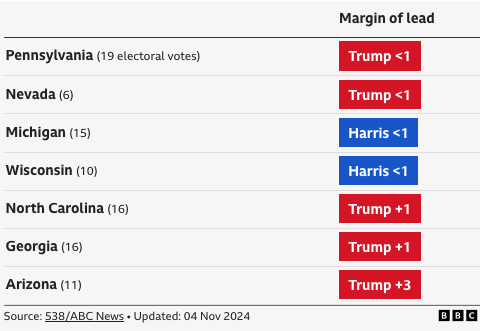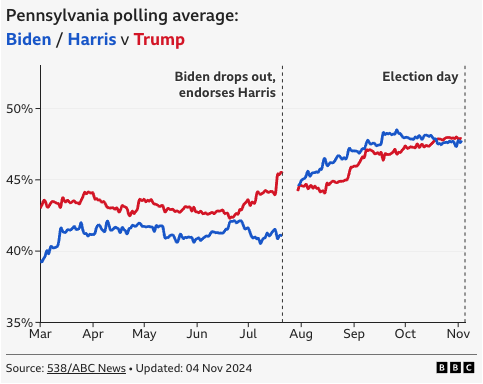
The 2024 U.S. presidential election has entered its final hours with polling data indicating a highly competitive race between Vice President Kamala Harris, representing the Democratic Party, and former President Donald Trump for the Republicans. Following President Joe Biden’s decision in July to withdraw and endorse Harris, she has maintained a slim national polling lead. However, swing state polling suggests that the Electoral College battle may come down to razor-thin margins.
National Polling Snapshot
Since Harris announced her candidacy, she has held a modest lead in national polling averages, enjoying a brief bump early in her campaign. This initial surge, which pushed her lead to nearly four percentage points by late August, has gradually narrowed. Recent polls show a tightening race, with Trump closing the gap in early November. According to the latest rounded figures, Harris remains slightly ahead, but the margin has shrunk significantly, suggesting an increasingly unpredictable race.
National polls provide a broad view of public sentiment, reflecting overall support for each candidate across the country. However, due to the Electoral College system, the national popular vote alone doesn’t decide the presidency. Instead, each state awards a set number of electoral votes based on its population, totaling 538 votes nationwide. To win the White House, a candidate must secure at least 270 electoral votes, making the battleground states critical for both campaigns.

Swing States: The Key to Victory

In a U.S. election landscape where most states reliably lean toward one party, attention is heavily focused on a handful of swing states—Arizona, Georgia, Nevada, North Carolina, Michigan, Pennsylvania, and Wisconsin. These states could go either way, making them pivotal for determining the winner.
Current polling in swing states shows a mixed picture:
- Arizona, Georgia, Nevada, and North Carolina: Trump holds a small but consistent lead in each of these states. Although these margins are slim and fluctuate slightly with each poll, Trump’s edge suggests a potential Republican stronghold in these regions.

- Michigan, Pennsylvania, and Wisconsin: Initially, Harris held a lead in these traditionally Democratic states, often by two or three percentage points. However, the race has tightened in recent weeks, particularly in Pennsylvania, where Trump now leads by a fraction of a percentage point. These three states were essential to Biden’s 2020 victory after Trump won them in 2016, flipping long-standing Democratic support.

The latest polling average from the seven key swing states reveals how precarious the margins are, with most showing leads of less than one or two points. Due to these close margins, the winner will likely depend on strong turnout and last-minute shifts in undecided voters.
Polling Methodology and Challenges
The polling averages in use, such as those from polling aggregator 538, are compiled from multiple sources. Each included poll meets specific criteria, like sample size transparency and methodology (e.g., online, telephone, or text surveys), to ensure data reliability. However, polling firms face ongoing challenges with capturing accurate sentiment, particularly among Trump supporters, who may be less likely to participate in traditional polling.
In both 2016 and 2020, polling underestimated Trump’s support due to multiple factors, including last-minute voter shifts and an under-sampling of non-college-educated voters, who have shown strong support for Trump. While adjustments have been made since then, the difficulty in capturing Trump’s base—particularly voters who do not regularly participate in elections—remains a challenge. This uncertainty, compounded by the unique dynamics of a high-turnout presidential election, raises questions about whether polling improvements will fully capture Trump’s support.
Polling experts have noted that while the 2022 midterms were one of the most accurate cycles in recent history, Trump’s absence from that election complicates comparisons. Analysts at 538 have noted that Trump tends to attract “irregular” voters, or individuals who may not participate in polls but who turn out on election day. This factor has caused some polling firms to adjust their turnout models, but predicting the extent of Trump’s impact remains challenging.
Why This Election Is Unique
Biden’s endorsement of Harris has shifted the dynamics of the race, especially in the swing states. When Biden exited the race in July, he was trailing Trump by nearly five points in swing states and was down by 4.5 points in Pennsylvania alone—a significant gap. Harris’s entry energized parts of the Democratic base, particularly younger voters and women, giving her a small but persistent lead in national polls and helping her regain some footing in key states.
The potential for a historic first female president has added momentum to Harris’s campaign, but it remains to be seen if this will translate to sufficient turnout in critical regions. Meanwhile, Trump’s return to the campaign trail and familiar messaging on issues like immigration, economic revitalization, and opposition to “Washington elites” has galvanized his supporters, some of whom are first-time or infrequent voters.
What’s at Stake
The election will determine whether the U.S. sees its first woman president or a return to Trump’s leadership, with both candidates promising different visions for America’s future. The stakes are high, as the race could have profound implications for policies on immigration, climate, healthcare, and the economy, along with global relationships.
The countdown to election day is in its final hours, with both campaigns focusing on motivating their bases and securing last-minute support in the most contested states. The outcome remains uncertain, with swing state voters likely to be the ultimate deciders.
Source & Images Courtesy :- BBC




